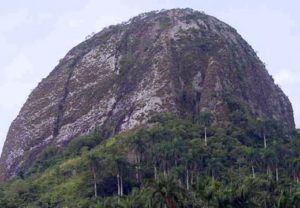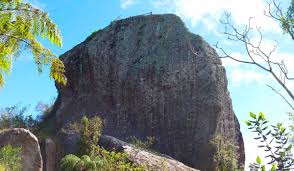EL GRAN ARCHIPIELAGO NATURAL QUE ES NUESTRA ISLA.
La República de Cuba es un archipiélago constituido por la isla mayor de las Antillas llamada Cuba, la Isla de la Juventud (antes Isla de Pinos) y 4.195 cayos, islotes e islas. Está ubicada en el Mar Caribe, cerca de las costas de los Estados Unidos y México. La superficie de Cuba es de 109.884 kilómetros cuadrados, pero si se incluyen las aguas costeras y territoriales sería de 110.860 kilómetros cuadrados. La isla de Cuba tiene 104.556 kilómetros cuadrados y cuenta con 5.746 kilómetros de costa y 29 kilómetros de fronteras, incluyendo la Bahía de Guantánamo, donde se encuentra la base naval de la Bahía de Guantánamo de la armada de los EE.UU.
Cuba, nuestro bello “largo verde”, es un archipiélago con un gran y deslumbrante patrimonio natural; parques nacionales, reservas naturales, playas y calas.
El Parque de la Sierra Maestra es uno de los mejores escenarios naturales. La Gran Piedra, una enorme roca de 70.000 toneladas y a 1.225 metros de altura, es uno de sus principales atractivos. Cuba siempre ha sido un destino amigo para el avido visitante.
Lo cierto es que cuando pensamos en la isla caribeña nos viene a la mente la imagen de sus ciudades: La Habana, Santiago, Trinidad… Pero, como cuenta ‘Rumbo’, Cuba es un archipiélago con un gran patrimonio natural: parques nacionales, reservas naturales, playas y calas. Cuba central comprende las provincias de Cienfuegos, Villa Clara, Sancti Spíritus, Ciego de Ávila y Camagüey y destaca por las ciudades de Cienfuegos y Trinidad, ambas declaradas Patrimonio de la Humanidad por la Unesco.
Las Tunas, Granma, Holguín, Santiago de Cuba y Guantánamo son las cinco provincias que se sitúan en la parte oriental de la isla de Cuba. Sus ciudades más importantes son Santiago de Cuba y Baracoa.
El tocororo (Priotelus temnurus) es el ave nacional de Cuba, que es autóctona de la isla. La flor nacional de Cuba es la “Flor de Mariposa” Hedychium coronarium, que fue importada de Indochina.
Destacan en la fauna cubana, mamíferos como las jutías, diversos murciélagos, reptiles (Cuba alberga una población de cocodrilos mayor que muchos otros lugares), anfibios (entre ellos la rana más pequeña del mundo), peces y animales marinos. La flora, con más de 6.500 especies sólo de plantas con semilla, bosques, plantas tropicales, de río y frutales.
La fauna cubana ha cambiado en el tiempo, pues la fauna actual dista de la del período cuaternario en Cuba. Los organismos vivos marinos abundan. Pueden ser cuevas, donde habitan peces ciegos, camarones, microorganismos y hongos. En los arrecifes de coral abundan los mismos, cuyos esqueletos calcáreos forman grandes masas. En ellas vive la carey y la caguama, dos tortugas amenazadas. Además hay peces como la guasa y otros de menor tamaño como los peces ángeles.
En tierra los suelos se llenan de insectos y en algunos sitios mamíferos insectívoros como el almiquí. En los árboles hay lagartos anolis y jutías (Capromyidae). Además de diversas aves endémicas como el tocororo (ave nacional), el zunzún y el catey. En las ciénagas habita el cocodrilo junto al mayito de ciénaga, la ferminia, la gallinuela de Santo Tomás y la garza.
Originariamente Cuba se encontraba llena de una espesa vegetación pero luego de un tiempo (principalmente durante la dominación española) ha sido degradada para desarrollar la agricultura. No obstante existen muchos programas para el cuidado y mantenimiento de estos bosques, que albergan gran diversidad. Las maderas preciosas de Cuba son muy cotizadas. Entre ellas el cedro, la caoba, la teca y otras.
Destacan en la fauna cubana, mamíferos como las jutías, diversos murciélagos, reptiles (destacando la numerosa población de cocodrilos), anfibios (entre ellos la rana más pequeña del mundo), peces y animales marinos. También abundan los insectos y mamíferos insectívoros.
THE GREAT NATURAL ARCHIPELAGO THAT IS OUR ISLAND.
The Republic of Cuba is an archipelago made up of the largest island in the Antilles called Cuba, the Isla de la Juventud (formerly Isla de Pinos) and 4,195 cays, islets and islands. It is located in the Caribbean Sea, near the coasts of the United States and Mexico. Cuba’s surface is 109,884 square kilometers, but if coastal and territorial waters are included it would be 110,860 square kilometers. The island of Cuba has 104,556 square kilometers and has 5,746 kilometers of coastline and 29 kilometers of borders, including Guantanamo Bay, where the US Navy Guantánamo Bay naval base is located.
Cuba, our beautiful “long green”, is an archipelago with a great and dazzling natural heritage; national parks, nature reserves, beaches, and coves.
Sierra Maestra Park is one of the best natural settings. The Great Stone, a huge rock of 70,000 tons and 1,225 meters high, is one of its main attractions. Cuba has always been a friendly destination for the avid visitor.
The truth is that when we think of the Caribbean island, the image of its cities comes to mind: Havana, Santiago, Trinidad … But, as ‘Rumbo’ says, Cuba is an archipelago with a great natural heritage: national parks, reserves natural, beaches and coves. Central Cuba includes the provinces of Cienfuegos, Villa Clara, Sancti Spíritus, Ciego de Ávila, and Camagüey and stands out for the cities of Cienfuegos and Trinidad, both declared World Heritage Sites by Unesco.
Las Tunas, Granma, Holguín, Santiago de Cuba and Guantánamo are the five provinces that are located in the eastern part of the island of Cuba. Its most important cities are Santiago de Cuba and Baracoa.
The tocororo (Priotelus temnurus) is the national bird of Cuba, which is indigenous to the island. Cuba’s national flower is the “Butterfly Flower” Hedychium coronarium, which was imported from Indochina.
They stand out in Cuban fauna, mammals such as hutias, various bats, reptiles (Cuba is home to a population of crocodiles greater than many other places), amphibians (among them the smallest frog in the world), fish and marine animals. The flora, with more than 6,500 species of seed plants, forests, tropical plants, rivers, and fruit trees only.
Cuban fauna has changed over time, as the current fauna is far from that of the quaternary period in Cuba. Living marine organisms abound. They can be caves, where blind fish, shrimp, microorganisms, and fungi live. In coral reefs, they abound, whose limestone skeletons form large masses. The hawksbill and loggerhead live in them, two threatened turtles. There are also fish such as guasa and other smaller ones such as angelfish.
On land, the soils are full of insects and in some places insectivorous mammals such as the almiquí. On the trees, there are anole lizards and hutias (Capromyidae). In addition to various endemic birds such as tocororo (national bird), zunzún and catey. In the swamps, the crocodile lives next to the swamp mayito, the ferminia, the Santo Tomás chicken, and the heron.
Cuba was originally full of thick vegetation but after a time (mainly during the Spanish domination) it has been degraded to develop agriculture. However, there are many programs for the care and maintenance of these forests, which are home to great diversity. Cuba’s precious woods are highly prized. Among them cedar, mahogany, teak and others.
They stand out in the Cuban fauna, mammals such as the jutías, various bats, reptiles (highlighting the large population of crocodiles), amphibians (among them the smallest frog in the world), fish and marine animals. Insects and insectivorous mammals also abound.
Agencies / Wiki/ 20 Minutos / Various/ Internet Photos / Arnoldo Varona, PJ. / www.TheCubanHistory.com
THE CUBAN HISTORY, HOLLYWOOD.













